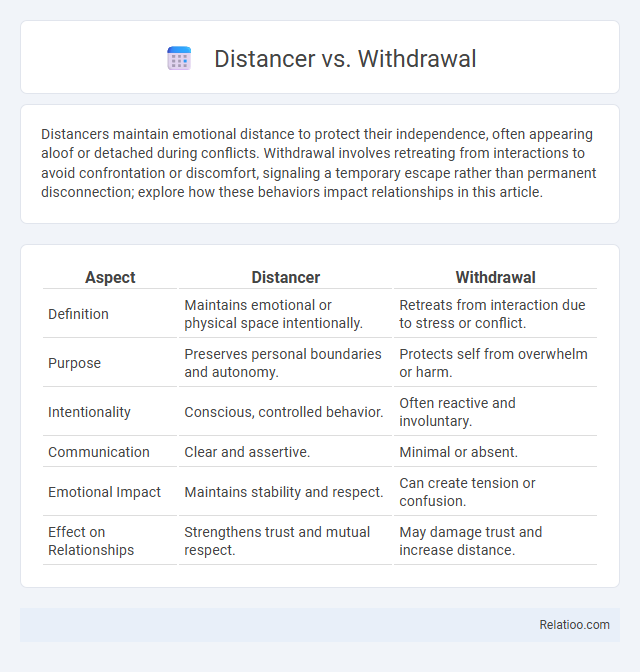Distancers maintain emotional distance to protect their independence, often appearing aloof or detached during conflicts. Withdrawal involves retreating from interactions to avoid confrontation or discomfort, signaling a temporary escape rather than permanent disconnection; explore how these behaviors impact relationships in this article.
Table of Comparison
| Aspect | Distancer | Withdrawal |
|---|---|---|
| Definition | Maintains emotional or physical space intentionally. | Retreats from interaction due to stress or conflict. |
| Purpose | Preserves personal boundaries and autonomy. | Protects self from overwhelm or harm. |
| Intentionality | Conscious, controlled behavior. | Often reactive and involuntary. |
| Communication | Clear and assertive. | Minimal or absent. |
| Emotional Impact | Maintains stability and respect. | Can create tension or confusion. |
| Effect on Relationships | Strengthens trust and mutual respect. | May damage trust and increase distance. |
Understanding Distancer and Withdrawal: Key Differences
Distancer and withdrawal both refer to behaviors characterized by emotional or physical disengagement in relationships, but they differ in motivation and impact. Distancers typically create space to maintain autonomy and protect themselves from perceived threats, while withdrawers tend to retreat due to feelings of overwhelm or inability to cope. Understanding these distinctions helps in addressing relational conflicts by tailoring communication and support strategies to each behavior's underlying needs.
Psychological Roots of Distancing and Withdrawing
Distancing and withdrawing are psychological defense mechanisms often rooted in past trauma, fear of intimacy, or emotional overwhelm, with distancers typically maintaining a physical or emotional space to protect their autonomy, while withdrawers may retreat due to anxiety or feelings of rejection. Your awareness of these behaviors can help identify patterns caused by unmet attachment needs or unresolved interpersonal conflicts. Understanding these roots allows for healthier communication and emotional regulation strategies to foster connection rather than isolation.
Signs You’re a Distancer vs. Someone Who Withdraws
Signs you're a distancer include a consistent need for personal space, difficulty with emotional intimacy, and a tendency to detach during conflicts without severing connections. Someone who withdraws often shows emotional shutdown, avoids communication altogether, and may become unresponsive during stressful situations. Recognizing these patterns helps you navigate relationships by addressing emotional needs and communication styles effectively.
Impact on Relationships: Distancers vs. Withdrawers
Distancers maintain emotional and physical space to manage stress, potentially causing partners to feel neglected or disconnected, whereas Withdrawers tend to retreat inwardly, leading to silence and emotional unavailability that can foster frustration and misunderstanding. Distancers often appear aloof but are seeking autonomy, while Withdrawers may struggle with vulnerability, resulting in different relational challenges. Both behaviors significantly impact communication patterns and intimacy, requiring tailored approaches for resolution and rebuilding trust.
Distancer Behavior: Causes and Motivations
Distancer behavior commonly arises from a desire for personal space and emotional safety, often triggered by past experiences of vulnerability or conflict. This pattern involves maintaining physical or emotional distance to avoid overwhelming intimacy or potential rejection. Understanding the underlying causes, such as fear of engulfment or need for autonomy, helps explain why distancers withdraw and resist closeness in relationships.
Withdrawal Patterns: Triggers and Dynamics
Withdrawal patterns involve a complex interplay of emotional triggers such as fear of rejection, anxiety, or unresolved conflicts that prompt an individual to retreat from intimacy. Understanding your withdrawal dynamics requires recognizing signs like decreased communication, emotional shutdown, or physical distancing, which serve as coping mechanisms during stress. Addressing these triggers effectively can help rebuild connection and foster healthier relationship patterns.
Communication Breakdown: How Distancers and Withdrawers Respond
Distancers cope with relationship stress by seeking space and emotional distance to maintain control and avoid feeling overwhelmed, often resulting in closed-off communication. Withdrawers retreat internally, shutting down emotionally and refraining from sharing feelings, which deepens misunderstandings and emotional disconnect between partners. Your awareness of these distinct responses can help identify patterns in communication breakdowns, fostering more effective strategies for reconnecting and resolving conflicts.
Healing Attachment Wounds: Distancer and Withdrawer Strategies
Distancers and withdrawers both employ avoidance behaviors to cope with attachment wounds, but distancers maintain emotional distance while staying physically present, whereas withdrawers physically retreat to create space. Healing attachment wounds requires recognizing these patterns and fostering secure communication to rebuild trust and emotional connection. Therapeutic approaches emphasize increasing emotional availability and vulnerability to transform these defensive strategies into healthy relational dynamics.
Navigating Conflict: Tips for Distancers and Withdrawers
Navigating conflict as a Distancer or Withdrawer involves recognizing your natural tendency to retreat from emotional confrontations and developing healthier communication strategies. You can benefit from setting clear boundaries while expressing your feelings calmly to avoid escalating tension. Practicing mindful self-awareness helps both Distancers and Withdrawers maintain connection without sacrificing personal space during disagreements.
Seeking Support: Therapy Options for Distancer and Withdrawal Behaviors
Distancer and Withdrawal behaviors often stem from emotional discomfort, making therapy a vital option for managing these responses. Cognitive-behavioral therapy (CBT) helps You recognize and adjust patterns of avoidance, while attachment-based therapy addresses underlying relational fears driving the distancer's need for space and the withdrawer's retreat. Tailored support ensures improved communication and healthier emotional connections in relationships affected by these behaviors.

Infographic: Distancer vs Withdrawal
 relatioo.com
relatioo.com